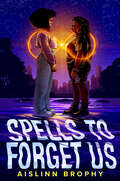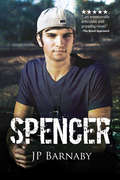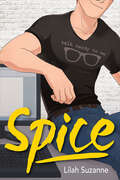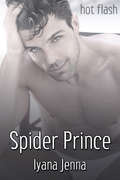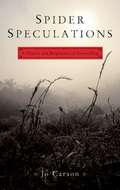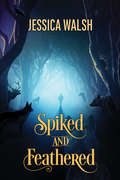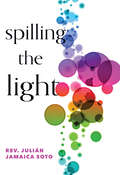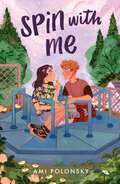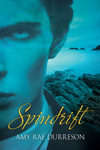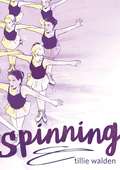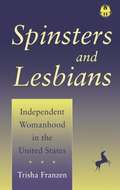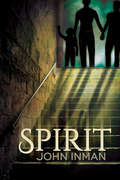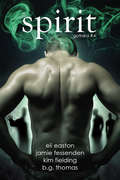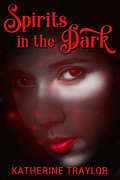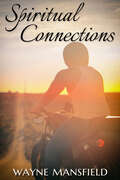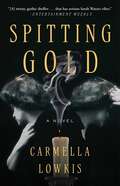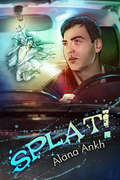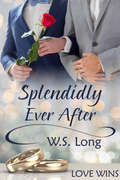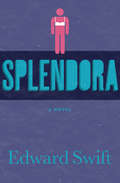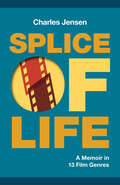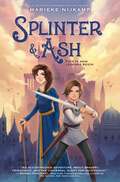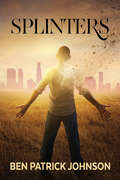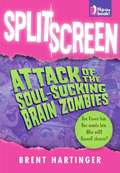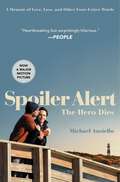- Table View
- List View
Spells to Forget Us
by Aislinn BrophyA witch and a non-magical girl get stuck in an endless cycle of meet-cutes and breakups in this heart-stopping romantic young adult fantasy."A seamless, mind-bending exploration of love and identity that manages to completely re-invent the time-loop story....You&’ll never read a book quite like this again." —Mark Oshiro, #1 New York Times bestselling author of Into the LightLuna is a powerful witch. Known for her skills and feared for her temper, she&’s set to preserve her family&’s legacy by becoming the head of Boston&’s Witch Council—a job she does not want.Aoife is a non-magical girl. Raised under the lens of her influencer family, she&’s grown up in the public eye. Now she yearns for privacy—but knows her parents won&’t oblige.Just when they are at their lowest, Aoife and Luna find each other and start dating. As decreed by magic law, Luna casts a spell that will erase Aoife&’s memories of their history together if they ever break up. But when Aoife and Luna end things, it&’s both of them who forget . . . that is, until they meet again, fall for each other, and recover all the memories of their last attempt at dating.So begins the story of two star-crossed lovers who keep finding their way into each other&’s orbits, even as the universe pulls them apart. When they set out to break the cycle, will they be strangers forever or together at last?"A whirlwind of whimsical romance and examinations of autonomy and familial duty." —Jas Hammonds, award-winning author of We Deserve Monuments
Spencer (A Survivor Story #3)
by J. P. BarnabyA Survivor StoryIt's been nearly five years since Aaron woke up in the hospital so broken, he couldn't stand the sight of his own face. The flashbacks no longer dominate his life, but he's still unable to find intimacy with his lover, Spencer Thomas. With time, patience, and the support of his family, his therapist, and his loving partner, Aaron has figured out how to live again. The problem is, Spencer hasn't. His life has been on hold as he waits for the day he and Aaron can have a normal relationship. Hoping to move things forward for them both, he takes a job as a programmer in downtown Chicago, leaving Aaron alone. Reeling in the wake of Spencer's absence, Aaron receives another shock when his attackers are caught. Now, he must testify and verbalize his worst nightmare. Publicly reliving his trauma without Spencer at his side destroys his precarious control. But he finds someone who can understand and empathize in Jordan, who watched his brother cut down in a school shooting. With Spencer gone and the DA knocking at his door, Aaron seeks solace in Jordan, and Spencer will have to risk everything to hold on to Aaron's love.
Spice
by Lilah SuzanneAs writer of the popular sex advice advice column, Simon Beck has an answer to every relationship question his readers can throw at him. When it comes to his own life, the answers are a little more elusive--until computer troubles introduce him to the newest and cutest member of his companys iT support team. Simon may be charmed by Benjis sweet and unassuming manner, but will he find the answer to the one relationship question he has never been able to solve: How to know when hes met Mr. Right?
Spider Prince
by Iyana JennaThe eight-legged monster Ghaelt wasn’t always the way he is now. He might’ve been hairy in the past, but he definitely wasn’t eight-legged. It was the work of a witch that cursed him like this. And to return to his usual self, there is something he needs to do.Aleich Rhaydyn should know not to wander at the forest at night, for there are many unnamed creatures who might or might not have foul intentions to him. He ends up getting abducted by the spider Ghaelt. But that isn’t all that’s waiting for him. Is he ready for the surprise coming from his captor?
Spider Speculations
by Jo Carson"I've spent about 15 years plus some working with people's stories in a series of communities in this country. I write plays from oral histories for those communities. Just finished my 30th. I'm watching people's lives and communities literally change, sometimes drastically, for the work. Spider Speculations is the beginning of trying to understand the hows and whys of all the changes."--Author Jo CarsonJo Carson lays bare her personal investigation into her own creative process after a spider bite on her back begins a series of life-altering events. Spider Speculations applies cutting edge mind-body science, quantum physics and ancient shamanistic techniques to describe how stories work in our bodies and our lives, and what happens when real stories are used in a public way. Carson, whose ability to capture the spoken word hallmarks her community-based work, sets down this story in her own distinctive voice, interspersing the journey with examples of her performance work. This truly original American book will speak to anyone thinking about art and community or engaging with people's stories.Jo Carson is a writer and performer living in John City, Tennessee. She has published award-winning plays, short stories, children's books, essays, poems and other work. Her play Whispering to Horses and solo show If God Came Down...premiered at Seven Stages in Atlanta. She currently performs Liars, Thieves, and Other Sinners on the Bench, made up of selected stories from her oral history plays, which will be published by TCG in 2007.
Spiked and Feathered
by Jessica WalshAnthony's had the day from hell at his call center job, and he plans to drink away the memory, so he finds the nearest club and gets started. Lucky for him there's an attractive man in the crowd who's willing to act without too many questions. A hot trip to the back of the bar and some heavy action is in order. The next morning Anthony wakes in an unfamiliar bed to a hellish headache and the heavenly scent of coffee. He didn't ask questions the night before, so why ask them now? Okay, maybe one. Why does his attractive one-night stand have feathers?A story from the Dreamspinner Press 2016 Daily Dose package "A Walk on the Wild Side."
Spilling the Light
by Julián Jamaica SotoThe light must spill to shine. The thing you must be is yourself. Intimate and uncompromising, Rev. Julián Jamaica Soto’s debut collection Spilling the Light is a luminous offering to their communities and a defiant declaration of their worth in a world hostile to their queer, disabled, and brown being. “America, is this freedom?” they ask. “I cannot prove to you that / I am a person,” writing boldly of identity, community, liberation, and erasure through a prism of tender moments and powerful reckonings. These are poems of broken hallelujahs and codes/witching, of hunger and fire, of hope and resilience. They are complex, tender, and empowering. They embolden us to become our truest selves, willing us to survive.
Spin with Me
by Ami PolonskyFrom the author of the critically acclaimed Gracefully Grayson comes a thoughtful and sensitive middle-grade novel about non-binary identity and first love, Ami Polonsky's Spin with Me. In this elegant dual narrative, Essie is a thirteen-year-old girl feeling glum about starting a new school after her professor dad takes a temporary teaching position in a different town. She has 110 days here and can't wait for them to end. Then she meets Ollie, who is nonbinary. Ollie has beautiful blue eyes and a confident smile. Soon, Essie isn’t counting down the days until she can leave so much as she’s dreading when her time with Ollie will come to an end. Meanwhile, Ollie is experiencing a crush of their own . . . on Essie. As Ollie struggles to balance their passion for queer advocacy with their other interests, they slowly find themselves falling for a girl whose stay is about to come to an end. Can the two unwind their merry-go-round of feelings before it's too late?
Spindrift
by Amy Rae DurresonWhen lonely artist Siôn Ruston retreats to the seaside village of Rosewick Bay, Yorkshire, to recover from a suicide attempt, he doesn't expect to encounter any ghosts, let alone the one who appears in his bedroom every morning at dawn. He also doesn't expect to meet his ghost's gorgeous, flirty descendant working at the local museum... and the village pub, and as a lifeboat volunteer. But Mattie's great-great-grandfather isn't the only specter in Rosewick Bay, and as Siôn and Mattie investigate an ill-fated love affair from a bygone era, they begin a romance of their own, one that will hopefully escape the tragedy Mattie's ancestor suffered. But the ghosts aren't the only ones with secrets, and the things Siôn and Mattie are keeping from each other threaten to tear them apart. And all the while, the dead are biding their time, because the curse of Rosewick Bay has never been broken. If the ghosts are seen on the streets, local tradition foretells a man will drown before the summer's end.
Spinning
by Tillie WaldenTillie Walden's Eisner Award winning graphic memoir Spinning captures what it’s like to come of age, come out, and come to terms with leaving behind everything you used to know.It was the same every morning. Wake up, grab the ice skates, and head to the rink while the world was still dark.Weekends were spent in glitter and tights at competitions. Perform. Smile. And do it again.She was good. She won. And she hated it.For ten years, figure skating was Tillie Walden’s life. She woke before dawn for morning lessons, went straight to group practice after school, and spent weekends competing at ice rinks across the state. Skating was a central piece of her identity, her safe haven from the stress of school, bullies, and family. But as she switched schools, got into art, and fell in love with her first girlfriend, she began to question how the close-minded world of figure skating fit in with the rest of her life, and whether all the work was worth it given the reality: that she, and her friends on the team, were nowhere close to Olympic hopefuls. The more Tillie thought about it, the more Tillie realized she’d outgrown her passion—and she finally needed to find her own voice.This title has Common Core connections.A New York City Public Library Notable Best Book for TeensA Chicago Public Library Best Book of 2017A 2018 YALSA Great Graphic NovelA 2017 Booklist Youth Editors' Choice
Spinsters and Lesbians: Independent Womanhood in the United States
by Trisha FranzenAmericans have long held fast to a rigid definition of womanhood, revolving around husband, home, and children. Women who rebelled against this definition and carved out independent lives for themselves have often been rendered invisible in U.S. history. In this unusual comparative study, Trisha Franzen brings to light the remarkable lives of two generations of autonomous women: Progressive Era spinsters and mid-twentieth century lesbians. While both groups of women followed similar paths to independence--separating from their families, pursuing education, finding work, and creating woman-centered communities--they faced different material and cultural challenges and came to claim very different identities. Many of the turn-of-the-century women were prominent during their time, from internationally recognized classicist Edith Hamilton through two early Directors of the Women's Bureau, Mary Anderson and Freida Miller. Maturing during the time of a broad and powerful women's movement, they were among that era's new women, the often-single women who were viewed as in the vanguard of women's struggle for equality. In contrast, never-married women after World War II, especially lesbians, were considered beyond the pale of real womanhood. Before the women's and gay/lesbian liberation movements, they had no positive contemporary images of alternative lives for women. Highlighting the similarities and differences between women-oriented women confronting changing gender and sexuality systems, Spinsters and Lesbians thus traces a continuum among women who constructed lives outside institutionalized heterosexuality.
Spirit
by John InmanJason Day, brilliant designer of video games, is not only a confirmed bachelor, but he's as gay as a maypole. One wouldn't think being saddled with his precocious four-year-old nephew for four weeks would be enough to throw him off-kilter. Wrong. Timmy, Jason's nephew, is a true handful. But just when Timmy and Uncle Jason begin to bond, and Jason feels he's getting a grip on this babysitting business once and for all, he's thrown for a loop by a couple of visitors--one from Tucson, the other from beyond the grave. I'm sorry. Say what? Toss a murder, a hot young stud, an unexpected love affair, and a spooky-ass ghost with a weird sense of humor into Jason's summer plans, and you've got the makings for one hell of a ride.
Spirit (Gothika #4)
by B. G. Thomas Jamie Fessenden Kim Fielding Eli EastonGothika: Volume FourSeeing dead people. Haunting and being haunted. Ghosts and those trying to deal with them add a supernatural flair to these four tales of romance. In Among the Dead, Neil Gaven sees dead people. A gentle ghost guides him to Trist, who needs his help. But Trist is tormented by spirits, so maybe together they can find a way to live among the dead. Dei Ex Machina is the story of Sabbio, a Roman slave who was killed 1700 years ago. He's been alone until he meets landscaper Mason. But because they're separated by centuries, it will take a miracle to make love work. The Mill brings a supernatural challenge to Frank Carter and his team of paranormal investigators. The owner's personal psychic, Toby Reese, is supposed to help. Frank doesn't have much respect for psychics, but when the dangers of the old mill threaten his team, he realizes he and Toby will have to work together to survive. Mike Ellsworth finds himself suddenly deceased. Now he's a ghost with lots left undone in Unfinished Business. He's never been able to be honest with his wife. He's never been able to tell the man he loves how he feels. He's barely been able to admit he's gay. If only there were a way he could make up for all he's failed to do....See excerpt for full individual blurbs.
Spirits in the Dark
by Katherine TraylorTrista has always loved abandoned houses and the paranormal. Now that she’s at college only fifteen minutes from the notoriously haunted Hollow Street house, she knows exactly where she’s spending Halloween. She packs a bag, puts on her favorite vintage dress, and sets off, hoping to spot the ghost of the young, dark-haired woman who’s said to haunt the house’s living room.Fellow student Keira does not like abandoned houses, and she isn’t particularly interested in ghosts. Visiting the Hollow Street house was not how she’d planned to spend Halloween. But her little sister, who loves all things spooky, has begged Keira to check out the haunted house next to her university, and Keira has trouble saying no. She doesn’t expect to see anything supernatural, so it’s quite a shock to find herself face-to-face with a mysterious young woman in old-fashioned clothing who seems to have appeared from nowhere.When the two ghost-hunters come face to face, each mistakes the other for the ghost she’s looking for. How tragic, they both think, that such a beautiful person should have died so young. Of course, things aren’t as bleak as they seem, and the two women might find themselves pleasantly surprised ... if they can make it to the morning. Because real entities haunt the Hollow Street house, and they’re anything but friendly.
Spiritual Connections
by Wayne MansfieldThe sound of the bathroom tap running late one night begins a mystery Devon is keen to solve. As small pieces of the puzzle are revealed, such as the man he discovers sitting on his couch in his house watching his television, he begins to wonder whether something paranormal isn’t going on. However, having been in a bad motorcycle accident a few months earlier, Devon cannot be sure these things he’s experiencing aren’t hallucinations caused by brain damage sustained in the tragedy.On the other hand, he’s more than a little taken by his hot new house guest, Brad, who is the epitome of manliness. Thick, muscular, hairy, and masculine. But his hotness doesn’t quite detract from the mystery of what he’s doing in Devon’s house, and since there’s no way of communicating with a spirit, Devon decides that, as Brad isn’t a malevolent ghost, there’s no reason he should be worried. Or even try to stop himself from falling love.Then a knock at the front door threatens to spoil everything. Unfortunately for Devon, there’s even worse to come. He has proven his ability to survive a motorbike accident, but has he got what it takes to survive what happens next?
Spitting Gold: A Novel
by Carmella LowkisA deliciously haunting, &“lush, and twist-filled tale&” (CrimeReads) that blends gothic mystery with a captivating sapphic romance as two estranged sisters—celebrated (and fraudulent) spirit mediums—come back together for one last con in 19th-century Paris.Paris, 1866: When Baroness Sylvie Devereux receives a house call from Charlotte Mothe, the sister she disowned, she fears her shady past as a spirit medium has caught up with her. But with their father ill and Charlotte unable to pay his bills, Sylvie is persuaded into one last con. Their marks are the de Jacquinots: dysfunctional aristocrats who believe they are haunted by their great aunt, brutally murdered during the French Revolution. The scheme underway, the sisters deploy every trick to terrify the family out of their gold. But when inexplicable horrors start to happen to them, too, the duo question whether they really are at the mercy of a vengeful spirit. And what other deep, dark secrets may come to light? Perfect for fans of Sarah Waters and Sarah Penner, Spitting Gold is &“an auspicious first outing from a writer to watch&” (Publishers Weekly, starred review).
Splat!
by Alana AnkhSplat! When a small creature has an unfortunate run-in with his car, Deacon Hearst wonders what in the world hit his windshield. A bird? A butterfly? No, that would make Deacon's crazy life too simple. It is a fairy--or rather a Sidhe--with a gaze the color of the moon and thus eloquently named Mooneyes. The little creature's wing is broken, and it's shivering in the rain, and well... Deacon has a heart, after all. While nursing Moon back to health, Deacon discovers Moon's beauty is more than skin deep. Though they're very different, especially in size, they're alike in their loneliness, their need for affection. Despite the weirdness of the situation, Deacon finds himself falling for his not-quite victim. Deacon thinks it's a hopeless--gah!--love, but what if it isn't? Moon might just have a few secrets of his own, secrets that could change everything in an instant and weave a different path for them both.
Splendidly Ever After
by W. S. LongSequel toAsk and I'll TellSeven years after they meet, and more than four years since RJ initially proposes, RJ and Pad are back. The wedding invitations have been sent again and the date is set. This time, both men are more committed than ever to each other and willing to make their relationship work.But old issues surface that cause conflict before their big day. Will RJ’s recent diagnosis of sexual addiction disorder tear them apart? Can they weather the growing disapproval from their families over same-sex marriage before they walk down the aisle? Will RJ and Pad finally tie the knot?
Splendora: A Novel
by Edward SwiftThe new librarian in the tiny town of Splendora, Texas, has a big secretA stunning and stylish femme fatale named Miss Jessie Gatewood has arrived in the dusty hamlet of Splendora. Miss Jessie is the new town librarian—but she has much bigger plans than just shelving books. She intends to give the town and its people a much-needed makeover. But even as she is influencing the fashion sense of the local ladies—and winning the heart of the lovesick Brother Leggett, Splendora&’s Baptist minister—a surprising plan for vengeance occupies the fabulous Miss Gatewood&’s mind.In Edward Swift&’s provocative, hilarious first novel, a small town is turned upside down by a new arrival—and a shocking return.
Splice of Life: A Memoir in 13 Film Genres
by Charles JensenMovies and memory intersect in this compelling and unconventional memoir from queer writer, film aficionado, and Jeopardy! contestant Charles Jensen.Splice of Life follows Jensen from his upbringing and struggles with sexual awareness in rural Wisconsin to his sexual liberation in college and, finally, to the complex relationships and bizarre coincidences of adulthood. Exploring what it means to be male and queer, each essay splices together Jensen' s lived experiences with his analysis of a single film. Deftly woven, Splice of Life shows us how personal and cultural memory intertwine, as well as how the stories we watch can help us understand the stories we all tell about ourselves.
Splinter & Ash (Splinter & Ash #1)
by Marieke Nijkamp“An essential middle grade fantasy where all readers will find heroes to love and to cheer!” —Alex London, author of Battle Dragons and The Princess Protection Program“Every kid deserves to see themselves as princesses or knights or whatever role they wish to play, and Nijkamp carves out the space for them to do so. Thoughtful, inclusive, and an outright joy, Splinter & Ash shines; a new classic that belongs on the shelves of every fantasy reader.” —Nicole Melleby, author of Hurricane Season and coeditor of This Is Our Rainbow“Splinter & Ash is a rare gem: a shining example of a fantasy novel that will engage readers of any age.” —A. J. Sass, award-winning author of Ellen Outside the Lines and Ana on the EdgeNew York Times bestselling author Marieke Nijkamp's middle grade prose debut is an immersive medieval fantasy starring queer and disabled young heroes. For two young misfits, a dangerous quest to save their kingdom will also mean saving each other. For fans of B. B. Alston’s Amari and the Night Brothers, Soman Chainani’s School for Good and Evil, and Tamora Pierce’s Tortall books.Ash—or Princess Adelisa—is the youngest child of the queen, recently returned to the city of Kestrel’s Haven after spending six years on the other side of the country. Ash was hoping for a joyous reunion, but the reality is far from it. Her mother is holding the kingdom together by a thread; her brother has only taunts and jibes for her; and court is full of nobles who openly mock and dismiss Ash, who uses a cane and needs braces to strengthen her joints.Splinter is the youngest child of one of Haven’s most prominent families. She’s fierce, determined, and adventurous, and she has her sights set on becoming a knight just like her older brother. Even if everyone says she can’t because she’s not a boy. So what? She’s not a girl, either.A chance encounter throws Ash and Splinter into each other’s orbits and changes the course of the kingdom's history. The princess and her new squire will face bullies, snobs, gossips, and their own disapproving families. But when they uncover a shadowy group of nobles plotting to overthrow the queen, they will show everyone how legends are born. Together.The first in a trilogy, bestselling author Marieke Nijkamp’s medieval fantasy is an action-packed love letter to nonbinary, queer, and disabled kids. Splinter & Ash evokes the classic adventure and atmosphere of fantasies by Lloyd Alexander and Tamora Pierce and the fresh, inclusive lens of writers such as Rick Riordan, Angie Thomas, and Soman Chainani. It invites everyone—no matter who they are or what they look like—to fight for what they believe in.
Splinters
by Ben Patrick JohnsonInspired by true events, Splinters is an American family tragedy infused with love and hope. After witnessing a horrific murder by their own mother in rural West Virginia, brilliant young Gerald and his baby sister Stephanie become orphans and find very different fates. Stephanie is quickly adopted, while Gerald languishes in a series of schools for boys. Eventually Gerald joins the Army and is recruited for intelligence work in a secret facility, where he becomes addicted to stimulants. When he gets thrown out of the Army for sexual impropriety, Gerald makes his way to Los Angeles, where he finds work as a go-go dancer and meets Aziah. Young, gay, and Black, Aziah identifies with Gerald's loneliness and difficulty fitting in. The two fall in love. Then Gerald's addiction and the ghosts of his past begin to surface, and he vanishes. When Stephanie shows up in Los Angeles, she and Aziah must confront the question of whether Gerald is so far gone that he can't recover.
Split
by Mel BossaQuiet and imaginative, Derek O'Reilly spends a lot of time watching a movie in his head. His fiancé Nathan wonders why Derek hasn't taken any interest in their wedding planning, and Aunt Fran -- his spiritual guru -- would like to know when her guilt-tripping nephew became a kept boy. When she drops Derek's childhood journal on his lap, he's forced to remember the name he's been trying to forget since he was twelve years old. Nicolai Lund.Nick was Derek's neighbor ... and first love.Weeks before Derek's engagement party, a chance meeting with Nick catapults Derek into the past. But Nick isn't that seventeen-year-old rebel anymore. He's a man hardened by invisible scars. A man struggling with grief.As Derek reads through his childhood diary, he realizes what Nick was to him, still is today, and yet might be ...NOTE: This edition has been expanded and substantially edited.
Split Screen
by Brent HartingerIt's a horror-movie extravaganza in this companion to Brent Hartinger's Geography Club! Two books in one recount the stories of best friends Min and Russel who sign up to be extras on the set of a zombie film - then learn that there's nothing scarier than high school romance! Read one story, flip the book over, and read the other! In Attack of the Soul-Sucking Brain Zombies, Russel must choose between his long-distance boyfriend and a close-to-home ex who wants to get back together. In Bride of the Soul-Sucking Brain Zombies, Min struggles to accept her cheerleader girlfriend's decision to stay in the closet. Russel and Min's separate stories affect each other in surprising ways - but you'll have to read both books to find out how!
Spoiler Alert: A Memoir of Love, Loss, and Other Four-Letter Words
by Michael AusielloIn this evocative and gorgeously wrought memoir reminiscent of Rob Sheffield’s Love Is a Mixtape and George Hodgman’s Bettyville, Michael Ausiello—a respected TV columnist and founder and editor-in-chief of TVLine.com—remembers his late husband, and the lessons, love, and laughter that they shared throughout their fourteen years together.For the past decade, TV fans of all stripes have counted upon Michael Ausiello’s insider knowledge to get the scoop on their favorite shows and stars. From his time at Soaps in Depth to his influential stints at TV Guide and Entertainment Weekly to his current role as founder and editor-in-chief of the wildly popular website TVLine.com, Michael has established himself as the go-to expert when it comes to our most popular form of entertainment. What many of his fans don’t know, however, is that while his professional life was in full swing, Michael had to endure the greatest of personal tragedies: his husband, Kit Cowan, was diagnosed with a rare and very aggressive form of neuroendocrine cancer. Over the course of eleven months, Kit and Michael did their best to combat the deadly disease, but Kit succumbed to his illness in February 2015. In this heartbreaking and darkly hilarious memoir, Michael tells the story of his harrowing and challenging last year with Kit while revisiting the thirteen years that preceded it, and how the undeniably powerful bond between him and Kit carried them through all manner of difficulty—always with laughter front and center in their relationship. Instead of a tale of sadness and loss, Spoiler Alert: The Hero Dies is an unforgettable, inspiring, and beautiful testament to the resilience and strength of true love.
